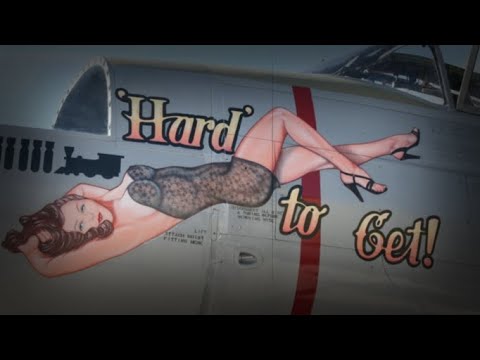During World War II, it was not uncommon to see fighter planes with elaborate and often risqué paintings on their noses. This became known as “nose art” and it had its origins in the early days of aviation.
As aircraft technology advanced, pilots began to personalize their planes with unique markings and designs. Nose art became particularly popular during World War II, when American and British air crews would decorate their planes with everything from pin-up girls to cartoon characters.
There is no definitive origin story for nose art, but historians believe it may have started with the practice of painting squadron insignias on planes. As pilots became more comfortable with the idea of customizing their aircraft, they began to add more elaborate designs.
One theory suggests that the first nose art was painted by German pilots during World War I. German fighter planes were known for their striking blue and green camouflage, but some pilots wanted to distinguish their planes from the others. They started painting designs on their planes, including the infamous Red Baron, who had a red Fokker Triplane with a cartoon of a dog on the side.
Nose art became more widespread during World War II, as American and British pilots used it as a way to personalize their planes and boost morale. Pin-up girls were a popular subject, as were images of animals, such as sharks and tigers. Some pilots even named their planes after their girlfriends or wives.
However, not all nose art was lighthearted. Many crews painted images of bombs and skulls on their planes as a warning to their enemies. Some nose art also had political messages, such as a plane named “Tokyo Rose” which featured an image of the famous Japanese propagandist.
Nose art continued to be popular after World War II, but it began to decline in the 1950s and 60s as military regulations became stricter. Today, nose art is still seen on some military aircraft, but it is much less common than it was during World War II.
Despite its controversial nature, nose art remains an important part of aviation history. It is a symbol of the creativity and individuality of the pilots and crews who risked their lives in the skies during World War II.
During World War II, nose art became a popular way for military pilots to personalize their aircraft. The practice began in the United States Army Air Service, and quickly spread to other countries and branches of the military.
The origins of nose art can be traced back to the practice of painting insignia on the sides of World War I aircraft. As military aviation technology advanced, the space available for artwork on the aircraft increased, and pilots began to decorate their planes with more elaborate designs.
Nose art became especially popular among American bomber crews during World War II. Many of these crews were stationed in remote air bases, far from home and loved ones, and personalized nose art helped to boost morale and provide a sense of identity.
The designs themselves varied widely, from pin-up girls and cartoon characters to patriotic symbols and images of loved ones. Many of the designs were inspired by popular culture at the time, such as the “Vargas Girls” pin-ups by artist Alberto Vargas.
Despite its popularity, nose art was not without controversy. Some military officials saw it as a distraction from the serious business of war, and others were concerned about the potentially offensive nature of some of the designs. However, many pilots and crews continued to create and display nose art throughout the war.
Today, nose art is still a part of military aviation culture, although it is much less common than it was during World War II. Some military aircraft still feature nose art, and the tradition continues to inspire artists and aviation enthusiasts around the world.
During the course of the war, nose art became an integral part of American military aviation culture, with many aircraft adorned with unique designs and artwork. These designs ranged from pin-up girls and cartoon characters to patriotic symbols and personal messages. The artwork was often a source of morale and inspiration for the crew, helping them to maintain their spirits during long and dangerous missions.
Further, the popularity of nose art continued to grow after the war, with many civilian aircraft also sporting unique designs. However, by the 1960s and 1970s, changing social attitudes and stricter regulations meant that nose art became less prevalent. In recent years, there has been a resurgence of interest in nose art, with many vintage aircraft being restored to their former glory and adorned with original designs.
Overall, nose art played a significant role in the culture of American military aviation during World War II and continues to be a source of inspiration and fascination for aviation enthusiasts around the world. It remains a testament to the creativity and spirit of the men and women who served their country during the war.


